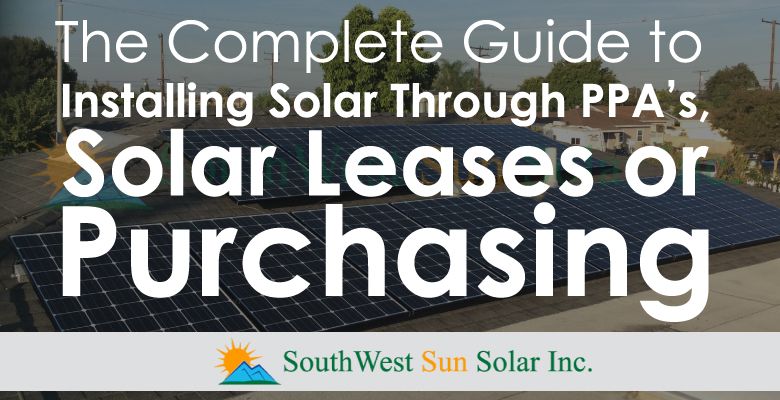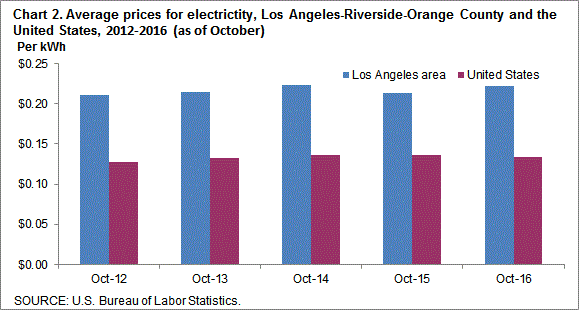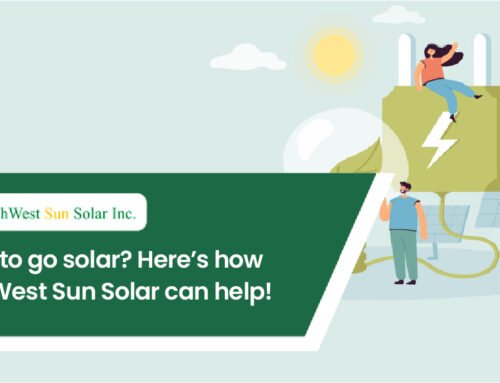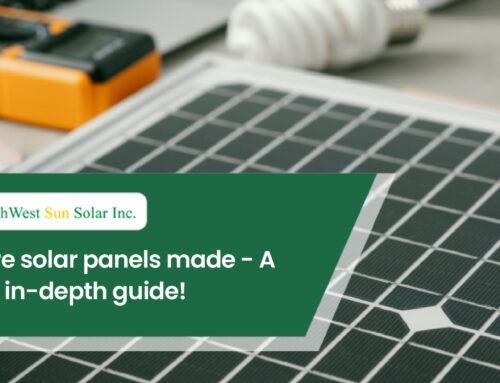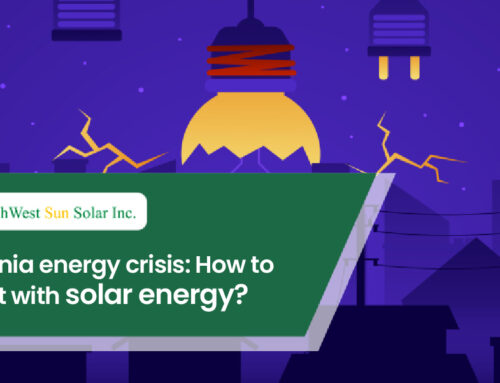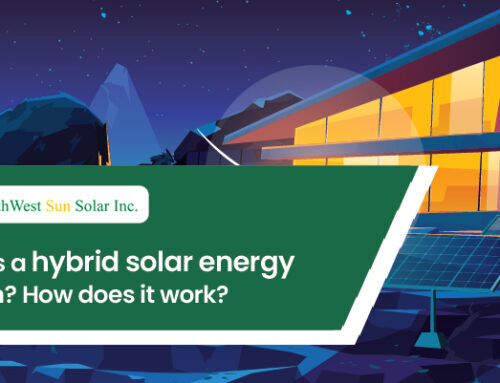Adding a solar installation is one of the best investments you can make for your property. Depending on your area, a well-managed and properly installed system qualifies for numerous tax credits and green energy credits, and can increase the value of your home. Since the electricity produced by a solar system is free, a solar installation eventually pays for itself, often in as little as a few years.
If you’re looking to invest in solar, understanding the different options for financing your installation is an essential first step.
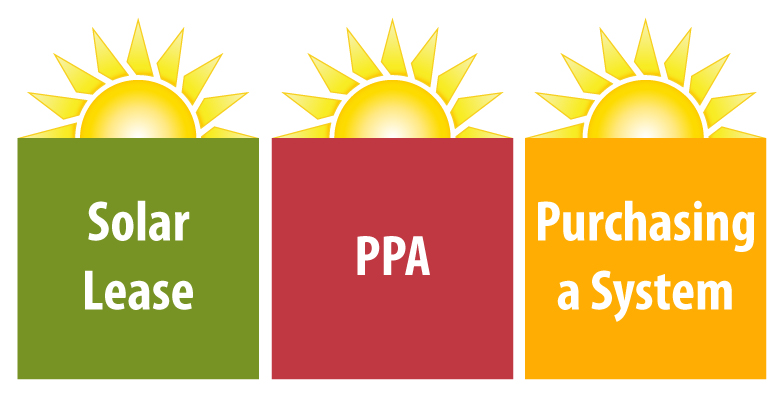
Solar Installation Options
There are generally three paths to installing solar on your home: leasing a system, entering a power purchasing agreement, or purchasing your system outright. All three options involve installing a solar system on your property, but each option provides unique financial benefits for homeowners depending on your budget and your investment goals.
Here are some basic definitions for each option:
- Solar Lease: A solar lease is an agreement with a solar leasing company. Your system will be owned and maintained by the solar leasing company, and installed for free. You pay a monthly rate for your solar panel system, but receive free electricity from the panels that offsets the monthly cost of the lease.
- Power Purchasing Agreement (PPA): A power purchasing agreement or PPA is similar to a solar lease. You’ll pay nothing for the installation or maintenance of the solar system, which will be owned by the solar company. In a PPA, you pay for the electricity produced by the system directly. This electricity costs less than the electricity provided by your utility.
- Purchasing a System: Paying for your system yourself is the simplest path for owning your solar system, but the initial cost of a solar panel system can be the biggest hurdle for homeowners. A solar system generally costs between $15,000 and $30,000 before tax credits and incentives.
What’s the Difference between a Solar Lease and a PPA?
Solar leases and PPA’s are very similar to one another. Under both agreements, the solar system will be installed for free and will be owned and maintained by the installer. In many cases, the differences between leasing and entering a PPA can be purely semantic. Your path to ownership and the amount you’ll end up paying for your electricity will be about the same under either agreement.
Solar leases and PPA’s can be thought of as a rental agreement. Essentially, the solar company is renting your roof space for their solar panels, which they’ll benefit from over time through tax benefits and incentives. In exchange, you receive a reduced electricity rate, and depending on your area, the value of your home may increase with a solar system. Both parties benefit under the terms of the agreement.
To understand the difference between a solar lease and a PPA, it’s important to understand each option.
Solar Lease Agreements
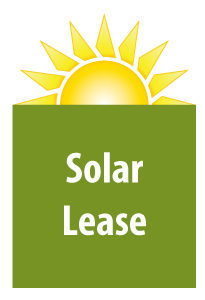 Under a lease agreement, you pay nothing for the electricity produced by the system, which greatly reduces your energy bill. You’ll be required to pay a monthly rate to your solar leasing company for your use of the solar system, but there’s no upfront costs for installation and no maintenance or upkeep. The monthly cost of your solar system will be less than the cost of the electricity you’ll get from the solar system. In effect, the system is free and you’ll save money over time from your reduced electricity bill, even after paying the monthly lease cost.
Under a lease agreement, you pay nothing for the electricity produced by the system, which greatly reduces your energy bill. You’ll be required to pay a monthly rate to your solar leasing company for your use of the solar system, but there’s no upfront costs for installation and no maintenance or upkeep. The monthly cost of your solar system will be less than the cost of the electricity you’ll get from the solar system. In effect, the system is free and you’ll save money over time from your reduced electricity bill, even after paying the monthly lease cost.
In a solar lease agreement, the solar leasing company owns your system. That means they’ll also receive the associated tax benefits and incentives, which will allow them to profit off of the system installed on your home. Most solar leasing agreements are for a 20-year period, although the lease terms vary greatly between companies. At the end of your lease agreement, the solar panels can be removed from your home, or you can choose to enter into a new agreement. Many leasing companies also offer a path to ownership for the solar system, allowing you to purchase the system at market rate at any time during the leasing agreement.
Solar leases are transferrable when you sell your home. Your solar leasing company will simply enter a new agreement with the new homeowner.
Power Purchasing Agreements (PPA)
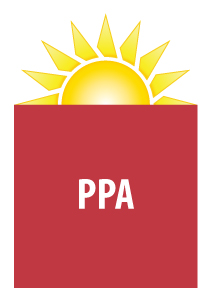 A power purchasing agreement is similar to a lease. It’s essentially a rental agreement with a solar company. The solar system will be installed and maintained by the solar company, and they’ll own your system and benefit from all tax incentives. In a PPA, you pay the solar company for the electricity produced by your system. This electricity will cost less than the electricity you used to purchase from your utility, saving you money over time. Unlike a lease, there’s no monthly cost for the system itself.
A power purchasing agreement is similar to a lease. It’s essentially a rental agreement with a solar company. The solar system will be installed and maintained by the solar company, and they’ll own your system and benefit from all tax incentives. In a PPA, you pay the solar company for the electricity produced by your system. This electricity will cost less than the electricity you used to purchase from your utility, saving you money over time. Unlike a lease, there’s no monthly cost for the system itself.
The cost of the electricity produced by the solar system is fixed, and is cheaper than your utility’s rates. The electricity purchased through your PPA will increase at a predetermined rate, usually 2-5% per year, which is generally lower than the rate of increase of your utility. You’ll start saving money on your electricity bill immediately, and the amount you save will increase over time as electricity rates increase.
Compared to a solar lease, a PPA generally ends up saving you the same amount of money. The only difference between the two systems are the terms of the agreement. Both types of agreements may or may not include a path to ownership, depending on the terms dictated by the solar company.
Choosing between a Solar Lease and a PPA
Ultimately, choosing between a solar lease and a PPA comes down to the terms of the contract; there’s no inherent benefit to either option over the long term, but the terms of each individual contract will be different depending on the solar company. Consider both options equally as you shop between solar companies for the agreement terms that suit your long-term goals.
These are some common agreement terms that should be carefully considered when you compare solar leases and PPA’s:
- Monthly lease payments and electricity costs
- Duration of the agreement
- Purchasing options
- Performance monitoring and maintenance costs
- Lease/PPA transferral options (when selling your home)
Purchasing Your System
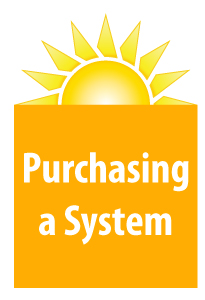 Purchasing your solar system directly from a solar company is a third option for homeowners who have the means to pay up-front for a solar installation. Solar installations generally cost between $15,000 and $30,000, but that cost is reduced in many states by a significant amount through solar tax rebates, tax credits, and incentives. Some states even offer green energy credit programs, where you can sell the electricity produced by your system back to the utility company.
Purchasing your solar system directly from a solar company is a third option for homeowners who have the means to pay up-front for a solar installation. Solar installations generally cost between $15,000 and $30,000, but that cost is reduced in many states by a significant amount through solar tax rebates, tax credits, and incentives. Some states even offer green energy credit programs, where you can sell the electricity produced by your system back to the utility company.
Purchasing a system allows you, the homeowner, to fully benefit from tax credits and incentives. This can reduce the cost of your system and reduce the time it takes for your system to pay for itself. In states that offer incentives, your system will generally pay for itself in 4-6 years, making solar a fantastic return on investment. Once your installation costs are offset by the electricity produced by your system, it still continues to produce electricity for 30 years or more.
Homeowners can also consider taking out a personal bank loan for their solar installation. These loans usually come with 10 or 20 year terms, with interest rates between 4-8%.
Green Energy Credits (SRECs)
Many states offer a green energy credit program called the SREC market for residential and commercial solar. These programs provide a marketplace where green electricity produced by solar panels can be bought and sold. Corporations, businesses, and homeowners can purchase green energy credits from the utility company to qualify for renewable energy tax credits and incentives, an attractive option for businesses looking to market their sustainability, or businesses that cannot install solar on-site.
If you choose to sell your green energy credits back to the utility, you won’t receive any of the electricity savings from your system, but you can greatly shorten the amount of time it takes to see a return on your investment. Whether you choose to sell your credits or not, you’re still contributing to a greener electricity grid in your area.

What a Solar Lease / PPA Consultation Looks Like
Once you decide on a solar lease or PPA agreement that matches your long-term investment goals, it’s time to contact the solar company for a consultation. Once you book an appointment, a solar contractor meets with you on-site or at the contractor’s office to talk over your options for a solar system, from both a design and financing perspective.
What Does a Solar Consultant Consider?
Solar consultants who deal with the specific design of your system will evaluate your location, your home’s roof, the local climate, your energy bill, and your energy use patterns. These factors dictate the size and placement of a solar system on your property, so that it best suits your expected energy use and your budget. California is one of the best states for solar system efficiency, with an above-average number of sunny days each year.
In some cases, the location of your home, the direction your roof faces, the presence of tree cover, local snowfall rates, or a combination of these factors will impact the efficiency of a solar system enough that it won’t pay itself off. In that case, it won’t make economic sense for you to enter into a PPA or solar lease. If you’d like to install a solar system anyways because you’re passionate about contributing to green energy, the solar company you choose is usually willing to enter into a PPA or solar lease with you anyways, but you’ll pay more for the electricity or system than you’ll offset in your savings.
Consultants will also consider snow cover and soiling as potential impacts of your system’s efficiency. If your solar panels are exposed to dust from a nearby construction site or covered by snow, the overall electricity generation will be negatively impacted. A properly designed system accounts for this loss of efficiency in its design. For instance, your contractor may recommend a larger system size if you expect frequent snowfall.
Electricity Needs
Your electricity usage is a very important factor for a solar consultation. Homes that use more electricity are the best candidates for a solar system, because there is a higher potential for energy cost savings. Your energy use also changes over the course of the day, and peaks when you’re running things like air conditioning. Bringing six months of utility bills to your consultation is a good way to give your solar contractor a better idea of your usage patterns so your system can be tailored to your needs.
Understanding your energy use patterns can help you make better energy decisions to minimize your electricity usage. With some good energy use habits, you may be able to reduce the size of the system you’ll need, decreasing the total cost if you decide to purchase it from your solar lease company or PPA later on.
Step One: Designing a Solar System
A solar contractor analyzes your roof space to install a solar system that will receive maximum sun exposure. The longer a solar panel is exposed to direct sunlight, the more electricity it produces in a given day. A good design optimizes sun exposure and matches the system size to your energy use habits.
Once your system is designed, the engineering team analyzes your home to ensure that the integrity of your roof and electrical panel matches the safety specifications of the solar system. If your roof needs to be retrofitted to bear the weight of a solar system, many solar contractors are qualified roofing contractors or have a roofing specialist that they frequently consult with. Some solar companies may ask that you upgrade your electrical panel to handle the electricity produced by the system. SouthWest Sun Solar and the best solar contractors offer an electrical panel upgrade at no additional cost.
The better solar contractors also take the aesthetics of a system into account when designing a system. More advanced installations minimize the appearance of the “rack” or structure that secures the panels. Having your solar system aligned symmetrically with the angles of your roof can result in a more pleasing aesthetic.
Step Two: City and Utility Company Approval
Your local governance and your local utility company both need to sign off on the design of a solar system before you can tie it into the electrical grid. This ensures that the system meets any local ordinances for system size or placement, and ensures that the electricity company is ready to manage the electricity produced by your system. Almost all solar systems are grid-tied; your electricity flows directly to the power grid, and your energy savings is calculated through net metering, which allows your utility to credit you for the power your system produces.
Experienced solar companies are accustomed to working with your city and your utility company, and will design a system that meets the approval standards. The best solar contractors, including SouthWest Sun Solar, will even manage all of the permitting paperwork for your system for you, ensuring that the system is approved for all necessary permits with no additional inconvenience for the homeowner.
Step Three: Solar System Installation
Once your system is approved, the installation of your solar system can begin. This is where it pays to hire a high quality solar contractor because they will coordinate all necessary steps of the installation from start to finish. Once the system is complete, your contractor should also contact your city and utility to schedule final inspection of the system. Once your system is approved by both parties, your solar contractor is authorized to connect your system to the grid.
SouthWest Sun Solar and other high quality solar contractors take care of all these steps for you. Once the initial consultation is complete, all of the legwork for design, approval, installation, and activation will be handled for you, minimizing the inconvenience of the process and ensuring the installation is completed in a timely manner.
For a more in depth look at a timeline of a solar panel installation, reference our guide here.
Energy Rates
The cost of energy from your utility is a big consideration for your solar system. A good solar contractor will be intimately familiar with your local electricity rates, and some common usage patterns unique to your area.
In areas with cheaper electricity, it’s harder to offset the cost of your system over time. Areas with the highest electricity rates stand to benefit the most from the free electricity produced by a solar system. For residents of California, the cost of electricity from the utility company is significantly higher than the national average, making solar a very attractive option for homeowners.
Currently, electricity in California averages between 50 and 65% above the national average. Coupled with the sunny weather California enjoys year-round, a solar system will quickly offset its own cost. Los Angeles, Orange County, and Riverside all have a significantly lower cost of electricity from residential solar when compared to the cost of solar from the utility, so homeowners can be confident about the savings of a PPA, solar lease, or purchased solar system.
Conclusion
For Californians, solar offers a remarkably good return on investment. PPA’s and solar leases offer options for homeowners to reduce their energy bill without the upfront costs of owning a solar system directly. Each of the three solar installation options have different benefits and drawbacks, but all three offer a pathway to long-term savings. All three options also create more alternative energy production, reducing the nation’s dependence on fossil fuels and contributing to a healthier, greener planet.
Whether you’re invested in your bottom line or in saving the planet, solar power is a clear winner.
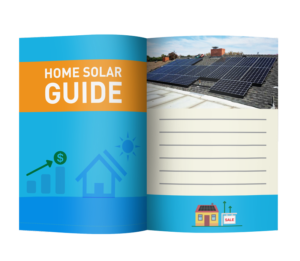 Can Solar Increase the Value of Your Home? Studies Show, Yes!
Can Solar Increase the Value of Your Home? Studies Show, Yes!

